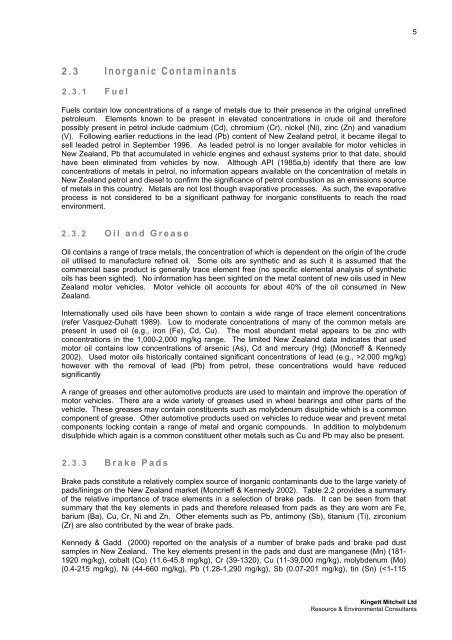The Effects of Road Transport on Freshwater and Marine Ecosystems
The Effects of Road Transport on Freshwater and Marine Ecosystems
The Effects of Road Transport on Freshwater and Marine Ecosystems
Create successful ePaper yourself
Turn your PDF publications into a flip-book with our unique Google optimized e-Paper software.
5<br />
2.3 Inorganic C<strong>on</strong>taminants<br />
2.3.1 Fuel<br />
Fuels c<strong>on</strong>tain low c<strong>on</strong>centrati<strong>on</strong>s <str<strong>on</strong>g>of</str<strong>on</strong>g> a range <str<strong>on</strong>g>of</str<strong>on</strong>g> metals due to their presence in the original unrefined<br />
petroleum. Elements known to be present in elevated c<strong>on</strong>centrati<strong>on</strong>s in crude oil <strong>and</strong> therefore<br />
possibly present in petrol include cadmium (Cd), chromium (Cr), nickel (Ni), zinc (Zn) <strong>and</strong> vanadium<br />
(V). Following earlier reducti<strong>on</strong>s in the lead (Pb) c<strong>on</strong>tent <str<strong>on</strong>g>of</str<strong>on</strong>g> New Zeal<strong>and</strong> petrol, it became illegal to<br />
sell leaded petrol in September 1996. As leaded petrol is no l<strong>on</strong>ger available for motor vehicles in<br />
New Zeal<strong>and</strong>, Pb that accumulated in vehicle engines <strong>and</strong> exhaust systems prior to that date, should<br />
have been eliminated from vehicles by now. Although API (1985a,b) identify that there are low<br />
c<strong>on</strong>centrati<strong>on</strong>s <str<strong>on</strong>g>of</str<strong>on</strong>g> metals in petrol, no informati<strong>on</strong> appears available <strong>on</strong> the c<strong>on</strong>centrati<strong>on</strong> <str<strong>on</strong>g>of</str<strong>on</strong>g> metals in<br />
New Zeal<strong>and</strong> petrol <strong>and</strong> diesel to c<strong>on</strong>firm the significance <str<strong>on</strong>g>of</str<strong>on</strong>g> petrol combusti<strong>on</strong> as an emissi<strong>on</strong>s source<br />
<str<strong>on</strong>g>of</str<strong>on</strong>g> metals in this country. Metals are not lost though evaporative processes. As such, the evaporative<br />
process is not c<strong>on</strong>sidered to be a significant pathway for inorganic c<strong>on</strong>stituents to reach the road<br />
envir<strong>on</strong>ment.<br />
2.3.2 Oil <strong>and</strong> Grease<br />
Oil c<strong>on</strong>tains a range <str<strong>on</strong>g>of</str<strong>on</strong>g> trace metals, the c<strong>on</strong>centrati<strong>on</strong> <str<strong>on</strong>g>of</str<strong>on</strong>g> which is dependent <strong>on</strong> the origin <str<strong>on</strong>g>of</str<strong>on</strong>g> the crude<br />
oil utilised to manufacture refined oil. Some oils are synthetic <strong>and</strong> as such it is assumed that the<br />
commercial base product is generally trace element free (no specific elemental analysis <str<strong>on</strong>g>of</str<strong>on</strong>g> synthetic<br />
oils has been sighted). No informati<strong>on</strong> has been sighted <strong>on</strong> the metal c<strong>on</strong>tent <str<strong>on</strong>g>of</str<strong>on</strong>g> new oils used in New<br />
Zeal<strong>and</strong> motor vehicles. Motor vehicle oil accounts for about 40% <str<strong>on</strong>g>of</str<strong>on</strong>g> the oil c<strong>on</strong>sumed in New<br />
Zeal<strong>and</strong>.<br />
Internati<strong>on</strong>ally used oils have been shown to c<strong>on</strong>tain a wide range <str<strong>on</strong>g>of</str<strong>on</strong>g> trace element c<strong>on</strong>centrati<strong>on</strong>s<br />
(refer Vasquez-Duhatt 1989). Low to moderate c<strong>on</strong>centrati<strong>on</strong>s <str<strong>on</strong>g>of</str<strong>on</strong>g> many <str<strong>on</strong>g>of</str<strong>on</strong>g> the comm<strong>on</strong> metals are<br />
present in used oil (e.g., ir<strong>on</strong> (Fe), Cd, Cu). <str<strong>on</strong>g>The</str<strong>on</strong>g> most abundant metal appears to be zinc with<br />
c<strong>on</strong>centrati<strong>on</strong>s in the 1,000-2,000 mg/kg range. <str<strong>on</strong>g>The</str<strong>on</strong>g> limited New Zeal<strong>and</strong> data indicates that used<br />
motor oil c<strong>on</strong>tains low c<strong>on</strong>centrati<strong>on</strong>s <str<strong>on</strong>g>of</str<strong>on</strong>g> arsenic (As), Cd <strong>and</strong> mercury (Hg) (M<strong>on</strong>crieff & Kennedy<br />
2002). Used motor oils historically c<strong>on</strong>tained significant c<strong>on</strong>centrati<strong>on</strong>s <str<strong>on</strong>g>of</str<strong>on</strong>g> lead (e.g., >2,000 mg/kg)<br />
however with the removal <str<strong>on</strong>g>of</str<strong>on</strong>g> lead (Pb) from petrol, these c<strong>on</strong>centrati<strong>on</strong>s would have reduced<br />
significantly<br />
A range <str<strong>on</strong>g>of</str<strong>on</strong>g> greases <strong>and</strong> other automotive products are used to maintain <strong>and</strong> improve the operati<strong>on</strong> <str<strong>on</strong>g>of</str<strong>on</strong>g><br />
motor vehicles. <str<strong>on</strong>g>The</str<strong>on</strong>g>re are a wide variety <str<strong>on</strong>g>of</str<strong>on</strong>g> greases used in wheel bearings <strong>and</strong> other parts <str<strong>on</strong>g>of</str<strong>on</strong>g> the<br />
vehicle. <str<strong>on</strong>g>The</str<strong>on</strong>g>se greases may c<strong>on</strong>tain c<strong>on</strong>stituents such as molybdenum disulphide which is a comm<strong>on</strong><br />
comp<strong>on</strong>ent <str<strong>on</strong>g>of</str<strong>on</strong>g> grease. Other automotive products used <strong>on</strong> vehicles to reduce wear <strong>and</strong> prevent metal<br />
comp<strong>on</strong>ents locking c<strong>on</strong>tain a range <str<strong>on</strong>g>of</str<strong>on</strong>g> metal <strong>and</strong> organic compounds. In additi<strong>on</strong> to molybdenum<br />
disulphide which again is a comm<strong>on</strong> c<strong>on</strong>stituent other metals such as Cu <strong>and</strong> Pb may also be present.<br />
2.3.3 Brake Pads<br />
Brake pads c<strong>on</strong>stitute a relatively complex source <str<strong>on</strong>g>of</str<strong>on</strong>g> inorganic c<strong>on</strong>taminants due to the large variety <str<strong>on</strong>g>of</str<strong>on</strong>g><br />
pads/linings <strong>on</strong> the New Zeal<strong>and</strong> market (M<strong>on</strong>crieff & Kennedy 2002). Table 2.2 provides a summary<br />
<str<strong>on</strong>g>of</str<strong>on</strong>g> the relative importance <str<strong>on</strong>g>of</str<strong>on</strong>g> trace elements in a selecti<strong>on</strong> <str<strong>on</strong>g>of</str<strong>on</strong>g> brake pads. It can be seen from that<br />
summary that the key elements in pads <strong>and</strong> therefore released from pads as they are worn are Fe,<br />
barium (Ba), Cu, Cr, Ni <strong>and</strong> Zn. Other elements such as Pb, antim<strong>on</strong>y (Sb), titanium (Ti), zirc<strong>on</strong>ium<br />
(Zr) are also c<strong>on</strong>tributed by the wear <str<strong>on</strong>g>of</str<strong>on</strong>g> brake pads.<br />
Kennedy & Gadd (2000) reported <strong>on</strong> the analysis <str<strong>on</strong>g>of</str<strong>on</strong>g> a number <str<strong>on</strong>g>of</str<strong>on</strong>g> brake pads <strong>and</strong> brake pad dust<br />
samples in New Zeal<strong>and</strong>. <str<strong>on</strong>g>The</str<strong>on</strong>g> key elements present in the pads <strong>and</strong> dust are manganese (Mn) (181-<br />
1920 mg/kg), cobalt (Co) (11.6-45.8 mg/kg), Cr (39-1320), Cu (11-39,000 mg/kg), molybdenum (Mo)<br />
(0.4-215 mg/kg), Ni (44-660 mg/kg), Pb (1.28-1,290 mg/kg), Sb (0.07-201 mg/kg), tin (Sn) (
















